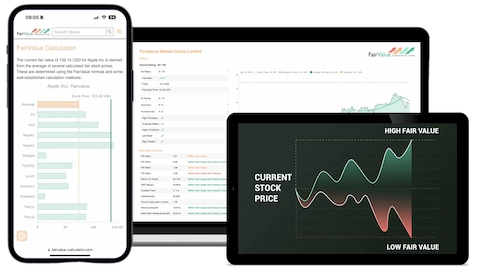Simple Fair Value Calculator
Use this Simple Fair Value Calculator to estimate the true value of any stock. Compare the calculated fair value to the current market price – and invest in stocks trading below their intrinsic value.
Get Even More Value!
- Instantly discover the Fair Value for over 45,000 stocks – fully automated, zero effort.
- The Pro Tool for serious investors: Automated stock analysis using 10+ valuation models.
- A powerful algorithm combines AI and over ten valuation models to calculate an average Fair Value – based on DCF, Buffett, Graham, PEG ratio, Peter Lynch, multiples, P/B, P/S and more!
How to Use the Simple Fair Value Calculator
Paste earnings per share (EPS) and revenue growth into this Simple Fair Value Calculator to get the approximate Fair Value of any stock. EPS and growth data can be found using a Google search, in the company’s annual reports under “Investor Relations,” or on major stock information portals:
- Enter the EPS (Earnings Per Share):
Input the company’s current or projected earnings per share. - Enter the Expected Growth Rate (%):
Provide the expected annual revenue or earnings growth rate of the company for the next few years. - Let the Tool Work:
The calculator will apply a simple formula using EPS and growth rate to estimate the stock’s fair value. - View Your Result:
The result shows you the simple fair value – giving you a quick estimation of whether the stock could be undervalued or overvalued. - For More Accurate Valuations:
Use our Advanced Fair Value Calculator to combine multiple valuation models for a more reliable result.
EPS (Earnings Per Share) represents the company’s net profit divided by its total number of shares. It shows how much profit is generated per share. EPS is typically found in:
- Automatically via our Premium Tool.
- Investor Relations Reports
- Yahoo Finance
- Your broker’s stock analysis section
The Expected Growth Rate usually refers to the company’s forecasted annual revenue growth. This rate can be based on:
- Analyst estimates (e.g. Yahoo Finance or Marketscreener)
- Company guidance (found in investor presentations)
- Automatically loaded in our Premium Tool.
Once you have both EPS and Growth Rate, simply enter them in the calculator to get an instant fair value estimate. For a detailed analysis, use the Advanced Fair Value Calculator. Insert earnings per share (EPS) and revenue growth into this Simple Fair Value Calculator to get the approximate Fair Value of the stock. EPS should be between 1 and 15, growth must be at least 2% for accurate results. The fair value is stated in the currency in which the EPS is entered. Use the Advanced Fairvalue-Calculator for more precise results.
Top 10 Stocks: Fair Value Strategy
This list is updated daily by our Stock Screener Tool, covering more than 60,000 stocks worldwide. Discover this and many other Top-Lists inside the Fairvalue Calculator Premium Tool – try it now for free!
Calculate Fair Value of a Stock in a Simple Way
The “Fair Value Calculator” at fairvalue-calculator.com is a financial tool used to calculate the fair value of a stock or company. The Simple Fair Value Calculator uses a simple formula to calculate a fair value estimate based on the company’s current financial data. This estimate can then be used as a basis for further analysis and considerations. It’s important to note that this calculator provides an estimate and is not an absolute statement of the fair value of any stock or company. It is always advisable to conduct a thorough financial analysis before investing in stocks.
The individual values needed for our free calculations can be found via a Google search, in the annual report on the company’s website under “Investors Relations” or on relevant share portals.
Note that all inserted values must be positive. To determine a more accurate fair value, you can use the additional free calculators or our Premium Tools. The formula used in this calculator is derived from the discounted cash flow method and has been optimized using specially developed algorithms.

💬 Comment by Dr. Peter Klein, Founder of Fairvalue Calculator:
The Basic Fair Value Calculator was the very first tool I developed. My goal back then was to create the simplest possible way to get a quick impression of how much a stock might actually be worth.
However, it's important to keep in mind: what is quick and easy is not always highly accurate. Especially when it comes to high-growth stocks, I noticed that this model tends to produce extremely high Fair Values — sometimes unrealistically so.
That’s why I later developed additional calculators to address this issue and provide more accurate results for companies with dynamic growth profiles. For traditional and more conservative companies, however, this basic model often provides a solid first sense of valuation.
I personally used it quite frequently in the early days — before the automated Premium Tools were available — to determine whether a company was worth a deeper look. As long as earnings per share remain in the single-digit or low double-digit range and growth is moderate, this calculator can offer surprisingly useful guidance.
For more precise estimations, I highly recommend exploring the advanced tools and calculators available on this website.
👉 Learn more about Fairvalue Calculator, our vision, and me.
Get Your Unlimited Access NOW!
100% Satisfaction - 0% Risk - Cancel Anytime.
FAQ: Simple Fair Value Calculator
A fast way to estimate intrinsic value with clean inputs—great for first passes before a full DCF.
What does the Simple Fair Value Calculator do? ▾
Which inputs do I need? ▾
- Starting metric (e.g., earnings or cash flow per share).
- Growth for the forecast window.
- Margin/efficiency assumptions if applicable.
- Discount rate or required return.
- Exit multiple or terminal growth for the end of the period.
How is this different from the full DCF Calculator? ▾
How should I choose a discount rate or required return? ▾
Exit multiple or terminal growth—what should I use? ▾
How do I handle cyclicality and one-off items? ▾
How do I cross-check the result with multiples? ▾
How do I read the output (fair value, upside, margin of safety)? ▾
Common mistakes to avoid ▾
- Mixing TTM with forward inputs inconsistently.
- Using an aggressive exit multiple or terminal growth.
- Ignoring dilution and capital structure in peer checks.
- Skipping sector and market context.
What’s a practical workflow with this tool? ▾
- Context: Review market and sector levels.
- Estimate: Run the Simple Fair Value Calculator.
- Cross-check: Use the EV Calculator and Stock Valuation.
- Deep dive: If promising, model details in the DCF.



